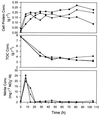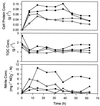Degradation of n-hexadecane and its metabolites by Pseudomonas aeruginosa under microaerobic and anaerobic denitrifying conditions
- PMID: 10653709
- PMCID: PMC91854
- DOI: 10.1128/AEM.66.2.493-498.2000
Degradation of n-hexadecane and its metabolites by Pseudomonas aeruginosa under microaerobic and anaerobic denitrifying conditions
Abstract
A strategy for sequential hydrocarbon bioremediation is proposed. The initial O(2)-requiring transformation is effected by aerobic resting cells, thus avoiding a high oxygen demand. The oxygenated metabolites can then be degraded even under anaerobic conditions when supplemented with a highly water-soluble alternative electron acceptor, such as nitrate. To develop the new strategy, some phenomena were studied by examining Pseudomonas aeruginosa fermentation. The effects of dissolved oxygen (DO) concentration on n-hexadecane biodegradation were investigated first. Under microaerobic conditions, the denitrification rate decreased as the DO concentration decreased, implying that the O(2)-requiring reactions were rate limiting. The effects of different nitrate and nitrite concentrations were examined next. When cultivated aerobically in tryptic soy broth supplemented with 0 to 0.35 g of NO(2)(-)-N per liter, cells grew in all systems, but the lag phase was longer in the presence of higher nitrite concentrations. However, under anaerobic denitrifying conditions, even 0.1 g of NO(2)(-)-N per liter totally inhibited cell growth. Growth was also inhibited by high nitrate concentrations (>1 g of NO(3)(-)-N per liter). Cells were found to be more sensitive to nitrate or nitrite inhibition under denitrifying conditions than under aerobic conditions. Sequential hexadecane biodegradation by P. aeruginosa was then investigated. The initial fermentation was aerobic for cell growth and hydrocarbon oxidation to oxygenated metabolites, as confirmed by increasing dissolved total organic carbon (TOC) concentrations. The culture was then supplemented with nitrate and purged with nitrogen (N(2)). Nitrate was consumed rapidly initially. The live cell concentration, however, also decreased. The aqueous-phase TOC level decreased by about 40% during the initial active period but remained high after this period. Additional experiments confirmed that only about one-half of the derived TOC was readily consumable under anaerobic denitrifying conditions.
Figures







References
-
- Altenschmidt U, Fuchs G. Anaerobic degradation of toluene in denitrifying Pseudomonas sp.: indication for toluene methylhydroxylation and benzoyl-CoA as central aromatic intermediate. Arch Microbiol. 1991;156:152–158. - PubMed
-
- Bai G, Brusseau M L, Miller R M. Biosurfactant-enhanced removal of residual hydrocarbon from soil. J Contam Hydrol. 1997;25:157–170.
-
- Bakker G. Anaerobic degration of aromatic compounds in the presence of nitrate. FEMS Lett. 1977;1:103–107.
-
- Ball H A, Reinhard M. Monoaromatic hydrocarbon transformation under anaerobic conditions at Seal Beach, California: laboratory studies. Environ Toxicol Chem. 1996;15:114–122.
-
- Barker J F, Patrick G C, Major D W. Natural attenuation of aromatic hydrocarbons in a shallow sand aquifer. Ground Water Monit Rev. 1987;7:64–71.
Publication types
MeSH terms
Substances
LinkOut - more resources
Full Text Sources
Other Literature Sources
Molecular Biology Databases

